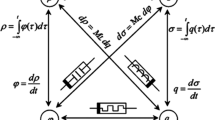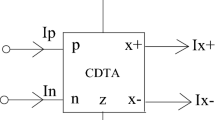Abstract
Meminductors are memory-based elements, which are gaining a lot of popularity as a result of their applications in widespread areas. However, due to the non-availability of their off-the-shelf ICs, designers are trying to find alternatives of meminductor emulators. This paper presents a generalized approach to designing a meminductor emulator from an active inductor circuit. An active inductor circuit having a current conveyor (CC), operational transconductance amplifier (OTA), and a grounded capacitor has been utilized. The idea is encouraged by the thought of putting memory in conventional active inductor circuits. In the proposed configuration, one additional block namely a current differencing buffered amplifier (CDBA) and an extra grounded capacitor have been used to modify the active inductor circuit into a meminductor emulator circuit. The goal is to implement a meminductor emulator employing active blocks which can be designed using commercially available ICs. Simulation results of the proposed emulator are obtained using the LTspice tool along with 0.18 µm CMOS technology parameters. The essential testimonials, pinched hysteresis loops, and non-volatility tests, confirm that the suggested circuit works as a meminductor emulator. Furthermore, the pinched hysteresis loops are observed for a large range of frequencies, verifying the wide dynamic frequency range of the suggested circuit. To assess how well the suggested meminductor emulator performs, a chaotic oscillator has been developed.


















Similar content being viewed by others
Code availability
The code is available with corresponding author. It can be provided on reasonable request.
References
Chua, L. (1971). Memristor-the missing circuit element. IEEE Transactions on circuit theory, 18(5), 507–519. https://doi.org/10.1109/TCT.1971.1083337
Strukov, D. B., Snider, G. S., Stewart, D. R., & Williams, R. S. (2008). The missing memristor found. Nature Publishing Group, 453(7191), 80–83. https://doi.org/10.1038/nature06932
Itoh, M., & Chua, L. (2019). Memristor cellular automata and memristor discrete-time cellular neural networks. Springer, Handbook of Memristor Networks. https://doi.org/10.1007/978-3-319-76375-0_47
Kim, K. H., Gaba, S., Wheeler, D., Cruz-Albrecht, J. M., Hussain, T., Srinivasa, N., & Lu, W. (2012). A functional hybrid memristor crossbar-array/CMOS system for data storage and neuromorphic applications. Nano letters, 12(1), 389–395. https://doi.org/10.1021/nl203687n
Hu, X., Duan, S., Wang, L., & Liao, X. (2012). Memristive crossbar array with applications in image processing. Science China Information Sciences, 55(2), 461–472. https://doi.org/10.1007/s11432-011-4410-9
Yang, J. J., Pickett, M. D., Li, X., Ohlberg, D. A. A., Stewart, D. R., & Williams, R. S. (2008). Memristive switching mechanism for metal/oxide/metal nanodevices. Nature Nanotechnology, 3(7), 429–433. https://doi.org/10.1038/nnano.2008.160
Pickett, M. D., Strukov, D. B., Borghetti, J. L., Yang, J. J., Snider, G. S., Stewart, D. R., & Williams, R. S. (2009). Switching dynamics in titanium dioxide memristive devices. Journal of Applied Physics, 106(7), 074508. https://doi.org/10.1063/1.3236506
Wang, X., Chen, Y., Gu, Y., & Li, H. (2009). Spintronic memristor temperature sensor. IEEE Electron Device Letters, 31(1), 20–22. https://doi.org/10.1109/LED.2009.2035643
Yadav, N., Rai, S. K., & Pandey, R. (2020). New grounded and floating memristor emulators using OTA and CDBA. International Journal of Circuit Theory and Applications, 48(7), 1154–1179. https://doi.org/10.1002/cta.2774
Gupta, S., & Rai, S. K. (2020). New grounded and floating decremental/incremental memristor emulators based on CDTA and its application. Wireless Personal Communications, 113(2), 773–798. https://doi.org/10.1007/s11277-020-07252-y
Yadav, N., Rai, S. K., & Pandey, R. (2021). Novel memristor emulators using fully balanced VDBA and grouned capacitor. Iranian Journal of Science and Technology, Transactions of Electrical Engineering, 45, 229–245. https://doi.org/10.1007/s40998-020-00357-x
Srivastava, P., Gupta, R. K., Sharma, R. K., & Ranjan, R. K. (2020). MOS-only Memristor emulator. Circuits, Systems, and Signal Processing, 39(11), 5848–5861. https://doi.org/10.1007/s00034-020-01421-x
Sharma, V. K., Parveen, T., & Ansari, M. S. (2021). Four quadrant analog multiplier based memristor emulator using single active element. AEU-International Journal of Electronics and Communications, 130, 152575. https://doi.org/10.1016/j.aeue.2020.153575
Ranjan, R. K., Sharma, P. K., Sagar, R. N., Kumari, B., & Khateb, F. (2019). Memristor emulator circuit using multiple-output OTA and Its experimental results. Journal of Circuits, Systems and Computers, 28(10), 1950166. https://doi.org/10.1142/S0218126619501664
Pershin, Y. V., & Ventra, M. D. (2010). Memristive circuits simulate memcapacitors and meminductors. Electronics Letters, 46(7), 517–518. https://doi.org/10.1049/el.2010.2830
Biolek, D., Biolkova, V., & Kolka, Z. (2020). Mutators simulating memcapacitors and meminductors. IEEE Asia Pacific Conference on Circuits and Systems. https://doi.org/10.1109/APCCAS.2010.5774993
Pershin, Y. V., & Di, V. M. (2011). Emulation of floating memcapacitors and meminductors using current conveyors. Electronics Letters, 47(4), 243–244. https://doi.org/10.1049/el.2010.7328
D-Sheng, Y, Yan, L., HHC, Iu, & Yi-Hua, H,. (2014). Mutator for transferring a memristor emulator into meminductive and memcapacitive circuits. Chinese Physics B, 23(7), 1–11. https://doi.org/10.1088/1674-1056/23/7/070702
Liang, Y., Chen, H., & Yu, D. S. (2014). A practical implementation of a floating memristor-less meminductor emulator. IEEE Transactions on Circuits and Systems II: Express Briefs, 61(5), 299–303. https://doi.org/10.1109/TCSII.2014.2312807
Sah, M. P., Budhathoki, R. K., Yang, C., & Kim, H. (2014). Charge controlled meminductor emulator. Journal of Semiconductor Technology and Science, 14(6), 750–754. https://doi.org/10.5573/JSTS.2014.14.6.750
Fouda M.E., & Radwan, AG (2014). Memristor-less current and voltage-controlled meminductor emulators. In: 21st IEEE International Conference on Electronics, Circuits and Systems (ICECS), pp 279-282. https://doi.org/10.1109/ICECS.2014.7049976
Sah, M. P., Budhathoki, R. K., Yang, C., & Kim, H. (2014). A mutator-based meminductor emulator circuit. IEEE International Symposium on Circuits and Systems (ISCAS). https://doi.org/10.1109/ISCAS.2014.6865618
Sah, M. P., Budhathoki, Y., & RK, & Kim, C. H. (2014). Mutator-based meminductor emulator for circuit applications. Circuits, Systems, and Signal Processing, 33(8), 2363–2383. https://doi.org/10.1007/s00034-014-9758-9
Yu, D., Liang, Y., Iu, H. H. C., & Chua, L. (2014). A universal mutator for transformations among memristor, memcapacitor, and meminductor. IEEE Transactions on Circuits and Systems II: Express Briefs, 61(10), 758–762. https://doi.org/10.1109/TCSII.2014.2345305
Wang, S. F. (2016). The gyrator for transforming nano memristor into meminductor. Circuit World, 42(4), 197–200. https://doi.org/10.1108/CW-01-2016-0002
Yu, D., Zhao, X., Sun, T., Iu, T., & HHC, Fernando,. (2019). A simple floating mutator for emulating memristor, memcapacitor, and meminductor. IEEE Transactions on Circuits and Systems II: Express Briefs, 67(7), 1334–1338. https://doi.org/10.1109/TCSII.2019.2936453
Zhao, Q., Wang, C., & Zhang, X. (2019). A universal emulator for memristor, memcapacitor, and meminductor and its chaotic circuit. Chaos: An Interdisciplinary Journal of Nonlinear Science, 29(1), 1–14. https://doi.org/10.1063/1.5081076
Taskiran, Z. G. C., Sagbas, M., Ayten, U. E., & Sedef, H. (2020). A new universal mutator circuit for memcapacitor and meminductor elements. AEU-International Journal of Electronics and Communications, 119, 1–11. https://doi.org/10.1016/j.aeue.2020.153180
Francisco, R. J., & Alfredo, M.-G. (2021). Design and implementation of a floating meminductor emulator upon Riordan gyrator. AEU: International Journal of Electronics and Communications, 133, 1–7. https://doi.org/10.1016/j.aeue.2021.153671
Bhardwaj, K., & Srivastava, M. (2021). New electronically adjustable memelement emulator for realizing the behaviour of fully-floating meminductor and memristor. Microelectronics Journal, 114(105126), 1–15. https://doi.org/10.1016/j.mejo.2021.105126
Kumar, K., & Nagar, B. C. (2021). New tunable resistorless grounded meminductor emulator. Journal of Computational Electronics, 20, 1452–1460. https://doi.org/10.1007/s10825-021-01697-5
Raj, A., Kumar, K., & Kumar, P. (2021). CMOS realization of OTA based tunable grounded meminductor. Analog Integrated Circuits and Signal Processing, 107, 475–482. https://doi.org/10.1007/s10470-021-01808-z
Demir, E., Yesil, A., Babacan, Y., & Karacali, T. (2021). Operational transconductance amplifier-based electronically controllable memcapacitor and meminductor emulators. Journal of Circuits Systems and Computers (World Scientific), 30(12), 2150222. https://doi.org/10.1142/S0218126621502224
Raj, N., Ranjan, R. K., Khateb, F., & Kumngern, M. (2021). Mem-elements emulator design with experimental validation and its application. IEEE Access, 9, 69860–69875. https://doi.org/10.1109/ACCESS.2021.3078189
Singh, A., & Rai, S. K. (2021). Novel meminductor emulators using operational amplifiers and their applications in chaotic oscillators. Journal of Circuits, Systems, and Computers, 30(12), 2150219. https://doi.org/10.1142/S0218126621502194
Singh, A., & Rai, S. K. (2021). VDCC-based memcapacitor/meminductor emulator and its application in adaptive learning circuit. Iranian Journal of Science and Technology, Transactions of Electrical Engineering, 45, 1151–1163. https://doi.org/10.1007/s40998-021-00440-x
Yadav, N., Rai, S. K., & Pandey, R. (2021). New grounded and floating memristor-less meminductor emulators using VDTA and CDBA. Journal of Circuits Systems and Computers, 30(15), 2150283. https://doi.org/10.1142/S0218126621502832
Yadav, N., Rai, S. K., & Pandey, R. (2022). New high frequency memristorless and resistorless meminductor emulators using OTA and CDBA. Sadhana, 47(8), 1–18. https://doi.org/10.1007/s12046-021-01785-z
Singh, A., & Rai, S. K. (2022). New meminductor emulators using single operational amplifier and their application. Circuits, Systems, and Signal Processing, 41(4), 2322–2337. https://doi.org/10.1007/s00034-021-01886-4
Singh, A., & Rai, S. K. (2022). OTA and CDTA-based new memristor-less meminductor emulators and their applications. Journal of Computational Electronics, 21(4), 1026–1037. https://doi.org/10.1007/s10825-022-01889-7
Yadav, N., Rai, S. K., & Pandey, R. (2023). An electronically tunable meminductor emulator and its application in chaotic oscillator and adaptive learning circuit. Journal of Circuits, Systems, and Computers, 32(2), 2350031. https://doi.org/10.1142/S0218126623500317
Yadav, N., Rai, S. K., & Pandey, R. (2023). Simple grounded and floating meminductor emulators based on VDGA and CDBA with application in adaptive learning circuit. Journal of Computational Electronics, 22(1), 531–548. https://doi.org/10.1007/s10825-022-01950-5
Aggarwal, B., Rai, S. K., & Sinha, N. (2023). New memristor-less, resistor-less, two-OTA based grounded and floating meminductor emulators and their applications in chaotic oscillators. Integration, 88, 173–184. https://doi.org/10.1016/j.vlsi.2022.10.005
Aggarwal, B., Rai, S. K., Arora, A., Siddique, A., & Das, R. (2023). A floating decremental /incremental meminductor emulator using voltage differencing inverted buffered amplifier and current follower. Journal of Circuits, Systems, and Computers,. https://doi.org/10.1142/S0218126623502432
Jain, H., Aggarwal, B., & Rai, S. K. (2023). New modified voltage differencing voltage transconductance amplifier (MVDVTA) based meminductor emulator and its applications. Indian Journal of Pure & Applied Physics, 61(4), 239–246. https://doi.org/10.56042/ijpap.v61i4.71313
Korkmaz, M. O., Babacan, Y., & Yesil, A. (2023). A new CCII based meminductor emulator circuit and its experimental results. AEU-International Journal of Electronics and Communications, 158, 154450. https://doi.org/10.1016/j.aeue.2022.154450
Bhardwaj, K., & Srivastava, M. (2023). VDTA and DO-CCII based incremental/decremental floating memductance/meminductance simulator: A novel realization. Integration, 88, 139–155. https://doi.org/10.1016/j.vlsi.2022.09.014
Ventra, M. D., & Pershin, Y. V. (2009). Putting memory into circuit elements: Memristors, memcapacitors and meminductors. Proceedings of the IEEE, 97(8), 1371–1372. https://doi.org/10.1109/JPROC.2009.2022882
Funding
Not applicable.
Author information
Authors and Affiliations
Corresponding author
Ethics declarations
Conflict of interest
There is no conflict of interest.
Additional information
Publisher's Note
Springer Nature remains neutral with regard to jurisdictional claims in published maps and institutional affiliations.
Rights and permissions
Springer Nature or its licensor (e.g. a society or other partner) holds exclusive rights to this article under a publishing agreement with the author(s) or other rightsholder(s); author self-archiving of the accepted manuscript version of this article is solely governed by the terms of such publishing agreement and applicable law.
About this article
Cite this article
Goel, A., Rai, S.K. & Aggarwal, B. A New Generalized Approach for the Realization of Meminductor Emulator and Its Application. Wireless Pers Commun 131, 2501–2523 (2023). https://doi.org/10.1007/s11277-023-10549-3
Accepted:
Published:
Issue Date:
DOI: https://doi.org/10.1007/s11277-023-10549-3




